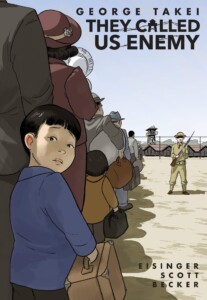Please register to join us at The Floyd County Library for the following discussions of the graphic novel They Called Us Enemy by George Takei, either in person at the New Albany Central Branch or online on Zoom. Free copies of the book are available at the Upper Customer Service desk at New Albany Central when you register.
Reading the Rainbow Book Group – Thursday, March 17 at 6 PM
A More Perfect Union Book Discussion – Thursday, March 24 at 6 PM
If you’ve ever watched Star Trek: The Original Series, you’ve seen actor George Takei playing Hikaru Sulu, but you may not have heard of Takei’s real-life history. Takei and his Japanese-American family were forced into internment camps during World War II, and the graphic novel They Called Us Enemy – co-written by Takei, Justin Eisinger, and Steven Scott, with art by Harmony Becker – tells this heartbreaking story.
They Called Us Enemy by George Takei, Justin Eisinger, and Steven Scott (2019), 204 pages. (Overdrive/Libby ebook) (Hoopla ebook)
In They Called Us Enemy, George Takei gives us some historical context of what lead up to Japanese-American internment during World War II, but young George had very little idea of what was happening when armed soldiers showed up at his family home and told them they had 10 minutes to pack. George, his parents, and his brother and sister were put on a bus that took them to Santa Anita racetrack, where they were forced to live in the horse stalls. To George, it was an interesting adventure – a strange vacation his family was taking. This impression was helped along by the fact that his parents were doing everything they could to keep from scaring or traumatizing their young children. Later, when they were sent on a train to a different internment camp, far away in Arkansas, George’s mother brought along special treats like books and candy that would make the trip something more positive for her children. Even so, George noticed the tension and fear on the faces of the adults around him, and through the graphic novel format we the reader can observe this as well.
Takei makes clear that although his memories are naively viewed through the eyes of a child, Japanese-Americans suffered greatly from internment and also other forms of racist treatment. They had to leave everything behind when they went to the camps, not knowing whether their homes or businesses would still be there when they returned. Some Japanese-Americans were coerced to give up their citizenship due to intimidation or unjust ultimatums from the government. The extent of injustice done to Japanese-Americans was not even officially recognized until Takei was already an old man. Takei also draws parallels between how his family was treated and how migrants on the southern border are treated today. This is an important American story told directly by a survivor, and the graphic novel format will hopefully make it accessible to a wide range of readers and students of history.
-Teresa Moulton, Children’s Librarian and Public Service Leader

